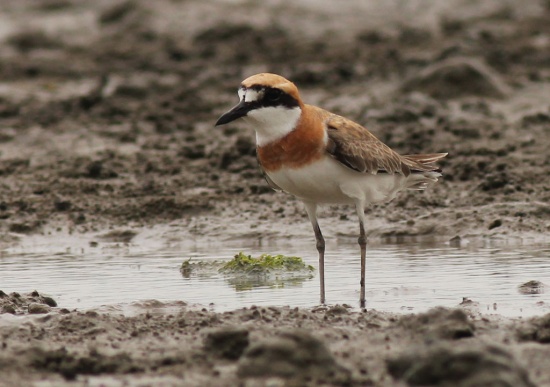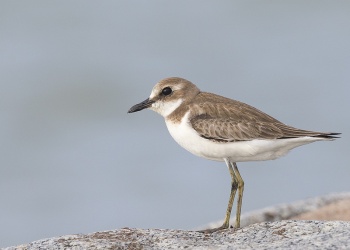- Anarhynchus leschenaultii
Charadrius leschenaultii
Identification
20–25 cm (7¾-9¾ in)
- Chestnut crown and upper breast
- Black mask
- White throat
Similar Species
Very similar to Siberian Sand Plover and Tibetan Sand Plover but differs by combination of following subtle features:
- larger size
- longer appearance
- squarer head
- thicker and longer bill with more tapered tip
- longer tibia
- typically paler legs usually tinged greenish or yellowish
Distribution
Breeds in south-central Asia; winters to southern Africa, southern Asia, and Australasia. Accidental vagrant to California (1 record).
Taxonomy
Subspecies
There are 3 subspecies1:
- A. l. columbinus:
- breeds Turkey to southern Afghanistan; winters south-eastern Mediterranean and Red Sea
- A. l. crassirostris:
- breeds Transcaspia to south-eastern Kazakstan; winters to South Africa
- A. l. leschenaultii:
- Western China to southern Mongolia and southern Siberia; winters Australasia
Habitat
Tidal flats, salt pans and estuaries.
Behaviour
Diet
Insectivorous; their main diet consists of beetles, snails and worms. They also eat shrimps, crabs, termites etc.
Gallery
Click on photo for larger image
Juvenile
Photo © by TAE-HEON CHOI
South Korea, August 2010Photo © by Lior Kislev
Maagan Michael, Israel, September 2012
References
- Clements, J. F., P. C. Rasmussen, T. S. Schulenberg, M. J. Iliff, T. A. Fredericks, J. A. Gerbracht, D. Lepage, A. Spencer, S. M. Billerman, B. L. Sullivan, and C. L. Wood. 2023. The eBird/Clements checklist of Birds of the World: v2023. Downloaded from https://www.birds.cornell.edu/clementschecklist/download/
- Handbook of the Birds of the World Alive (retrieved August 2014)
Recommended Citation
- BirdForum Opus contributors. (2024) Greater Sand Plover. In: BirdForum, the forum for wild birds and birding. Retrieved 25 April 2024 from https://www.birdforum.net/opus/Greater_Sand_Plover
External Links
GSearch checked for 2020 platform.1







